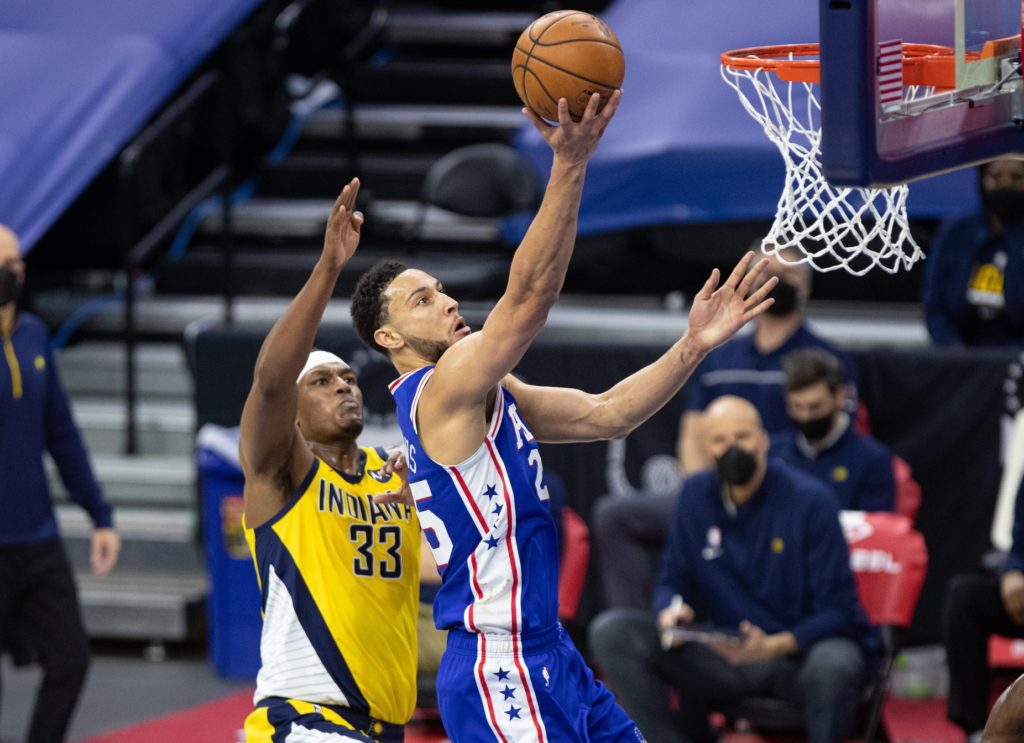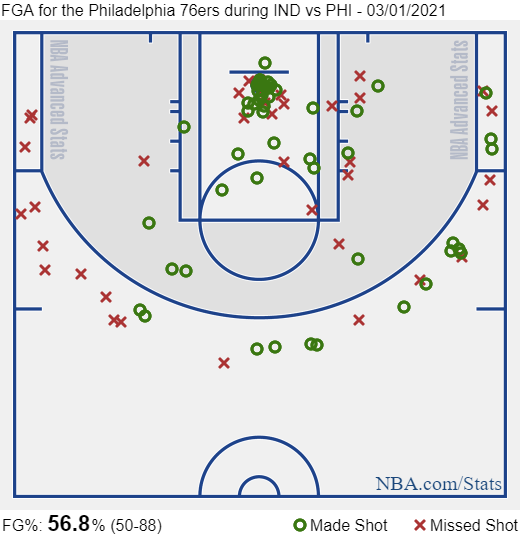Ad Disclosure
The Dorks are Right – Observations from Sixers 130, Pacers 114

“We still don’t shoot enough threes,” said Joel Embiid after Saturday night’s Cleveland loss.
Seems like his teammates got the message, because in a Monday win over Indiana, the Sixers knocked down 15 of 35 en route to a cut-and-dried home court win.
It was a victory in the analytics department, where the statistical dorks have been clamoring for more deep looks for several weeks now. And the thing is this:
The dorks are absolutely right. 100%.
The Sixers needed to balance their assets. Diversify their bonds. They needed to to restructure the figurative portfolio to make their offensive forays more efficient. Those are three financial examples we can apply to this specific basketball problem.
For more meaningful context, let’s point to the fact that the Sixers came into this game shooting only 29 three pointers per night, which was 28th in the league, or third-worst. But they shot the three at 36.4%, which is 16th, and basically smack dab in the middle of the league-wide chart. Their output was not logically congruent with the percentage at which they actually shoot the three, so this was really a fantastic example of improved shot selection.
“I loved how we spaced the floor,” said Doc Rivers. “That’s why I was so upset the other night; I thought we had no spacing. Tonight we spaced the floor, we got to the paint, and we made passes to each other. When I called that timeout (early) in the third I asked them, ‘why are we changing what we’re doing?‘ The first three or four possessions the paint was crowded, and then we got (the ball) back out. You could see Joel running down the floor like ‘space! keep it wide!’ And I just thought we passed the ball to each other well.”
The numbers back up Rivers’ assertions, absolutely. His team logged 27 assists, created 59 uncontested shots, and scored 93.3% of their three pointers off teammate passes. That’s pretty typical for a catch and shoot team that doesn’t pull up, but it still shows you how much they were spacing, catching, chucking, and hitting.
They actually shot three fewer field goals and turned the ball over 19 times, but when you hit at 57% from the floor and 43% from three, you wipe out those margins:
Good shot chart. Those Furkan Korkmaz corner threes really helped extend the lead, and they hit a lot of their looks right at the break lines.
“We still have the anchor in Joel,” Rivers said of the Sixers’ three-point shooting. “We’re going downhill, we’re making plays, we’re making shots, but when we have a lull after two or three times down the floor, we go to the post. And that still may lead to a three, but it’s going to lead to something good, and knowing that gives us comfort.”
This is important, though it’s kind of dumb and obvious when you explain it –
Obviously Joel Embiid and Ben Simmons are not three point shooters, but they’re going to take a large portion of shots on any given night. That’s why the diversity in shot selection has to come from the guys around them, i.e. Seth Curry, Danny Green, and Tobias Harris. Especially on a night when Harris is not available, it’s important for the other three players on the floor with Joel and Ben to disproportionately fire up threes. They did that Monday, with the group of Green, Curry, Mike Scott, and Furkan Korkmaz shooting 24 of their 29 shots from beyond. Add in Embiid and Simmons taking 26 of 28 looks from two, and that’s how they balance it out. It has to skew heavily in the other direction.
“When we do that, it becomes harder for the other team to double team,” said Joel Embiid of the three-point shooting. “If you make two threes in a row, I always like to watch the others team’s bench, and they’re always asking themselves ‘what are we doing? that’s two or three in a row.’ Then they might change it up. If you’re going to guard me one on one, that’s also hard to guard. That’s the key. I think we need to continue sharing the ball and letting it fly.”
The supporting cast
Scott, Curry, Korkmaz, and Shake Milton combined for 63 points, which is massive number. Especially for Korkmaz and Milton, who have been incredibly spotty lately, their contributions helped push that second quarter lead to double digits.
“It’s great, it’s what we need,” Rivers said. “You know, we’re still working with that group, trying to figure out what we can run that fits us the best. We ran some good stuff and I think our guys saw it, they kept running it, they kept finding each other. When those two play well off our bench, we’re pretty tough.”
Korkmaz matched a season high with 19 points on 6-14 shooting. Milton went for 20+ for the first time since mid-January.
“I think it’s just a team thing,” Milton added. “When the ball is moving like that, it’s hard to guard. The ball has energy and it’s gonna find people with energy. Furk can shoot it, and everybody knows that. It just takes one for him to get going. That’s what happened.”
Polite disrespect
Safe to say, Myles Turner is just not a great matchup for Joel Embiid, and Embiid said it straight-up after the game:
“He’s a great player, and I have a lot of respect for him. But I say this respectfully; this is a matchup I’ve dominated since I got to the league. Great defender, he’s leading the league in blocks and should be up there when it comes to Defensive Player of the Year, which is also one of my goals. In those tough matchups, you have to take advantage, especially if I have my eyes set on being Defensive Player of the Year.”
Turner can’t contain Embiid, but nobody can, really. Unless you’re Toronto and throwing early doubles and traps, there is not an ideal Embiid plan. And when the ball is moving the way it did Monday night, the spaced out shooters will make you pay. It’s more or less a picking of poison when the Sixers diversify their shot selection.
Kevin has been writing about Philadelphia sports since 2009. He spent seven years in the CBS 3 sports department and started with the Union during the team's 2010 inaugural season. He went to the academic powerhouses of Boyertown High School and West Virginia University. email - k.kinkead@sportradar.com
